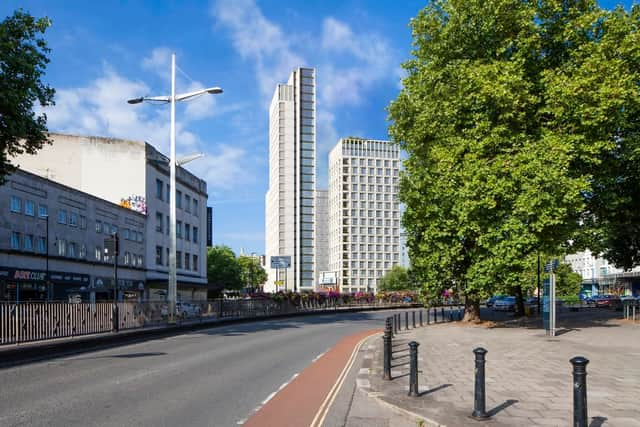Premier Inn Bear Pit: More revealed on plan to demolish hotel for student flats and ‘co-living’ space
and live on Freeview channel 276
A major plan to knock down Bristol city centre’s Premier Inn and replace it with two blocks providing student homes and ‘co-living’ space will go some way to meeting the local housing demand, say the team behind it.
Developer Olympian has launched a consultation on a proposal to knock down the hotel and build a 28-storey high L-shaped student apartment block with 442 bedrooms plus an 18-storey block for ‘co-living’ homes aimed at urban professionals.
Advertisement
Hide AdAdvertisement
Hide AdThe plans have, however, been met with concern on Bristol World’s Facebook page, mainly on it being another student accommodation development. One person posted: “More student accommodation. When are Bristol council going to build more family homes?” Another said: “So basically student flats and a hostel.”
Yesterday evening (June 20), planners behind the scheme provided a short presentation to the public online and took questions from Bristol World on the matters raised by readers.
Why more student housing
Asked why the 28-storey block - which would be the city’s tallest - would be for student accommodation, planning consultant Craig O’Brien said there was a ‘really significant shortfall’ in purpose-built homes for students in the city.
This is despite plans for 432 new student flats in Malago Road in Bedminster, 637 student flats in The Dings, and 480 students flats in St Philips to serve the new University of Bristol campus in Temple Quarter. Last year, plans were also approved for 471 student apartments on Avon Street.
Advertisement
Hide AdAdvertisement
Hide AdBut Mr O’Brien said there were 68,000 students in the city and still only 17,000 purpose-built student accommodation units. And he said the situation was likely to worsen with an almost-14,000 increase in students.
“There is definitely an acute problem,” he said. “It is worse in Bristol than in most university cities. There is alot of commentary about students finding it difficult to find accommodation and some have ended up living in places like Newport, Cheltenham and Gloucester.
“That’s clearly not sustainable for them or the universities or the city. It is something which needs to be dealt with.”
What is ‘co-living’
The planners went on to explain the concept of ‘co-living’ space within the smaller tower. There would be 132 studio apartments each with its own living space, bedroom, en-suite shower and small kitchen with a double-hob oven, refrigerator and dishwasher. The apartments would be an average 21 metre square in size.
Advertisement
Hide AdAdvertisement
Hide AdThe tenant would also share a two-storey shared living space with 15 other tenants. This would have a living room and lounge on one level, and a large kitchen on the other. There would also be access to a gym and cinema in the building.


As for the cost to rent, the planners said it would be around 20% cheaper than a one-bedroom flat, and would include bills and management.
Oliver d’Erlanger, senior development manager at Olympian Homes, said: “If you want to make breakfast in the morning, it [studio apartment] is very well set up for that. Get back late from work and want to make a quick supper, it is very well set up for that.
“But the whole idea of the concept is alot of the time you get back [and you] go into these larger communial kitchens where you have got 16 people sharing them with a living space. When you get back you cook on your own or together and you sit and eat as part of this larger community.”
Advertisement
Hide AdAdvertisement
Hide AdStephen Hodder, director of Hodder Architects, which designed the scheme, said: “The whole construction of a co-living is you can be an individual or in a small group or in a large group. It is to encourage people to come together in a community.”
The ‘co-living’ homes idea is not uncommon nationally, but in Bristol it’s fairly new. But this could be about to change. Along with this proposal for Premier Inn, 250 ‘co-living’ spaces are also proposed as part of a redvelopment of the Rupert Street car park nearby.
Mr d’Erlanger added: “There is a market for young professional who want a different option to an HMO or a one-bedroom flat. Having this different option is a good thing. Bristol has two very well regarded universities and that retention of students, co-living is something which helps with it.”
When could work start
The team also gave an update on when work could start. The next stage after the consultation would be a planning application, which if approved could mea work begins in 2025. Construction, the team said, would take two years.
This could be at the same time work takes place to knock down the former Debenham’s store and build homes.
To find out more about the plans, click on the developer’s website here.
Comment Guidelines
National World encourages reader discussion on our stories. User feedback, insights and back-and-forth exchanges add a rich layer of context to reporting. Please review our Community Guidelines before commenting.
